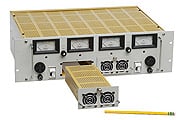Redundant Power Supply Systems
using Linear Regulated or Switching Regulated Power Supplies
AC-DC single output
Power Supplies listed by wattage (ranging from lowest to highest)Redundant Power Supply Packages provide redundant DC power in one package.
- Shipped Within 9 Days
- UL recognized Units Available
- Five Year Warranty

Wall Mount
Redundant Power
- Linear or Switching
- to 1200 watts
- All Models U.L. Recognized
Shipped Within 9 Days
Order Online
Rack Mount
Redundant Power
- Linear or Switching
- to 1200 watts
- All Models U.L. Recognized
Shipped Within 9 Days
Order Online
Pluggable
Redundant Power
- Switching
- to 277 watts
Shipped Within 9 Days
Order Online
Modular
Redundant Power
- Linear or Switching
- to 425 watts
Shipped Within 9 Days
Order Online
N+1 Power Supplies
Redundant Power
- Switching
- to 720 watts
- Rack, Modular, Benchtop

Custom
Redundant Power
- Custom power supplies and systems are available in any configuration, with features and power levels to meet your specified requirements.
- Learn More
Redundant Power Features & Benefits
An Acopian Redundant Power Package is installed by simply connecting the AC input and DC output terminals. All wiring (including isolation diodes, output monitor circuits, switches, meters, adjustments and connectors) has been done for you.
Output Redundancy: Each Redundant Power Package contains two identical power supplies with their outputs interconnected through a diode switching arrangement that will detect any fault condition, isolate it from the system output, and pass only the output of the other supply with no interruption of output power during the transition.
Input Redundancy: All Acopian Redundant Power Packages may be operated with only one AC power source. However, two isolated sets of AC input connections are provided, so that two independent sources of input power may be used, to obtain the additional protection of input redundancy. A battery- backup power source (UPS) and/or a second power line from the power utility can be used to maintain output power without interruption when your primary source of AC power fails.
Applications: Redundant Power Packages should be considered for any equipment where the highest attainable reliability is essential, and an unexpected loss of power would be disastrous. Such applications include communications systems (both voice and data types), computer systems (volatile memory systems in particular), process controls, utility and municipal systems, and security/safety alarm systems.
Theory of Operation: Each Redundant Power Package consists of the two power supplies installed in either a Rack Mounting or Wall Mounting assembly. The output voltage of the primary supply is set approximately 0.2 volt higher than that of the backup supply. Under this condition, the backup supply's diode is not forward biased; only the primary supply delivers current to the load. If the output voltage of the primary supply decreases by more than 0.2 volt, the situation is reversed and only the backup supply delivers load current. There is no interruption of output power during the transition.
Serviceability: A defective power supply can be rapidly and safely changed while the Redundant Power Package continues to furnish uninterrupted power to the load. All input, output and alarm-contact connections are at the rear of the assembly for Rack Mounting models or on the front for Wall Mounting models. For Rack Mounting models, the chassis slide and handle options are recommended for applications where it is desired to service the Redundant Power Package without removing it from the rack.
Monitoring Circuitry: The Redundant Power Package contains two voltage monitoring circuits with relays, contacts of which are available to control external failure alarms or other circuitry. The contact wiring of the two relays is connected in cascade, to simulate a single set of Form C contacts which switches if the output voltage of either power supply decreases by more than 2.0 volts (3.0 volts for outputs over 48 volts) from the nominal rating.
Overvoltage Protection: Automatic recovery. Each power supply contains an overvoltage protection circuit, to assure that neither power supply output will significantly exceed the nominal output voltage rating under any condition, including incorrect application and misadjustment.

 Made In The USA
Made In The USA


